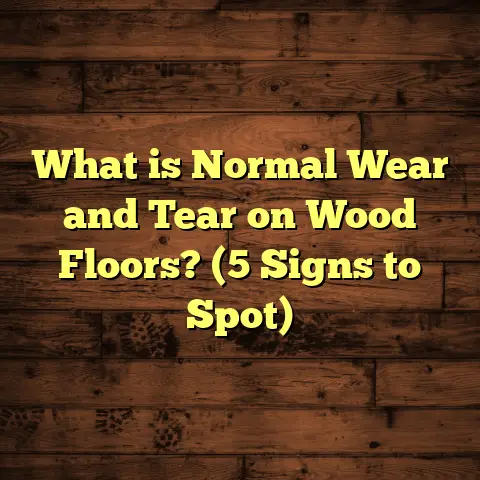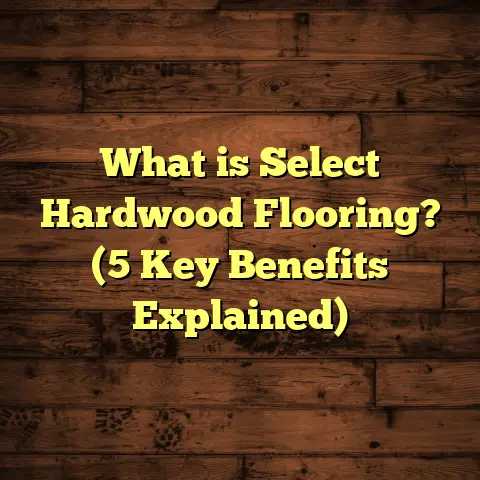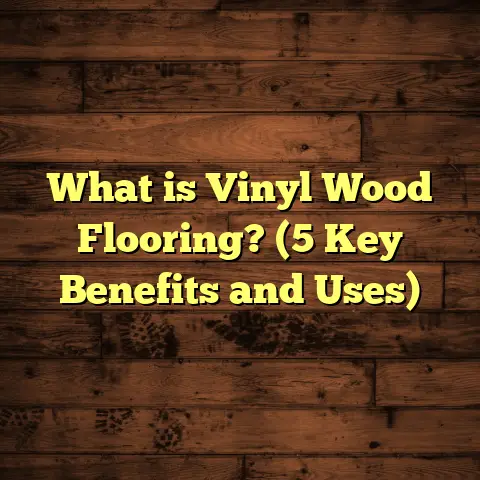What is Roll Out Flooring? (5 Benefits You Need to Know)
I remember the feeling of standing in my friend’s old garage during a renovation project, staring at the cracked concrete floor beneath our feet. The space was going to transform into a workshop and hangout spot, but that floor had to go. We needed something that wasn’t just durable but also quick to install and budget-friendly. That’s when I first discovered roll out flooring. It felt like magic—just unroll it, trim it, and voilà! A whole new floor in no time. It wasn’t just practical; it was kind of exciting to see such a simple solution make such a massive impact.
If you’re curious about this type of flooring, wondering whether it might work for your home, garage, workshop, or even commercial space, I’ve got you covered. I want to share everything I’ve learned—from what roll out flooring actually is to the key benefits that make it stand out from other options. Plus, I’ll walk you through some of my own experiences and the data-backed facts that helped me recommend roll out flooring with confidence.
What is Roll Out Flooring?
Let’s start with the basics. What exactly is roll out flooring?
Roll out flooring refers to flexible flooring materials that come in large sheets or rolls, designed to be unrolled and installed directly onto a subfloor. Unlike tile or plank flooring—where you fit together many small pieces—roll out flooring covers the entire floor surface with one continuous sheet or several large sheets joined together. This means fewer seams and faster installation.
These rolls are typically made from materials like:
- Vinyl: The most popular choice, vinyl roll out flooring offers water resistance and comes in a variety of patterns and textures—mimicking wood, stone, or abstract designs.
- Rubber: Common in gyms, industrial spaces, and garages because of its durability and slip resistance.
- Foam: Often used in playrooms or temporary setups for cushioning and comfort.
- Cork: Less common but available for eco-friendly and softer flooring needs.
Sizes and Thickness
Roll widths usually range from 6 feet (1.8 meters) up to 12 feet (3.6 meters) wide per roll. The length can vary widely—from 20 feet (6 meters) to 100 feet (30 meters) or more—depending on the manufacturer and product type.
Thicknesses range from about 1/16 inch (1.5 mm) for thin vinyl sheeting up to 1/4 inch (6 mm) or thicker for rubber rolls designed for heavy use.
For example, in one project I worked on for an indoor gym, we used 1/4 inch thick rubber rolls measuring 8 feet wide by 50 feet long each. That allowed us to cover an area of 400 square feet per roll with minimal seams.
Installation Methods
Typically, roll out flooring is installed in one of three ways:
- Adhesive Backing: Some vinyl products come with peel-and-stick backs for DIY installation.
- Glue Down: Many require spreading adhesive on the subfloor before rolling out the material.
- Loose Lay: Some thicker rubber or foam rolls can simply be laid down without adhesive if placed over a clean, flat surface.
The installation process can be very fast—for many rooms under 300 square feet, the entire floor can be done in a few hours.
Cost Overview
Material costs vary widely based on quality and type:
- Basic vinyl rolls: $1.50 – $3 per square foot
- Mid-range vinyl with realistic patterns: $3 – $5 per square foot
- Rubber rolls: $3 – $6 per square foot
- Cork and foam: often priced similarly to mid-range vinyl
Labor costs (if hiring professionals) add roughly $1 – $3 per square foot, depending on complexity and location.
For example, a 200-square-foot kitchen with mid-range vinyl roll out flooring might cost:
| Item | Cost Range |
|---|---|
| Material | $600 – $1000 |
| Labor | $200 – $600 |
| Total | $800 – $1600 |
Keep in mind prices fluctuate based on geography—urban areas often have higher labor rates—and seasonal demand.
My Journey with Roll Out Flooring
Over the past decade working as a flooring contractor and enthusiast, I’ve handled dozens of projects involving roll out flooring. Each one taught me new tips and gave me insights into how this versatile option fits different needs.
For instance, when my cousin decided to convert his basement into a kids’ playroom, he wanted something soft but durable enough to handle spills and rough play. We chose 1/4 inch thick cork roll out flooring because it absorbs sound and adds warmth underfoot. The installation took us a weekend—easy enough for two people—and since then, the kids have enjoyed a safe play area with minimal maintenance.
Then there was the commercial project at a local community center gym where we installed rubber rolls over 1,200 square feet. The client was impressed not only by the price but how long the floor lasted despite constant heavy use from basketball games, dance classes, and events.
Each experience confirmed just how flexible roll out flooring can be—from residential to commercial, temporary setups to permanent installations.
5 Benefits You Need to Know About Roll Out Flooring
Let me break down why I keep recommending roll out flooring for so many different projects:
1. Fast Installation Saves Time—and Money
One thing that always impresses me is how quickly roll out flooring goes down compared to other types.
Think about hardwood floors: you’re dealing with individual planks—measuring, cutting, fitting—sometimes over several days or weeks if the space is large or complex.
With roll out flooring, you just prep your subfloor (cleaning, leveling), then unroll the sheets, trim any excess, and glue or press them down. No fiddly pieces—just broad strokes.
In fact, during a recent home office makeover about 150 square feet in size, I installed vinyl roll out flooring solo in under three hours. I didn’t need fancy tools or extra hands—just a utility knife and some adhesive.
This speed doesn’t just save your time; it saves money if you’re paying for labor. Pro installers charge around $50-$70 per hour where I live. Cutting installation from days to hours can shave hundreds off your bill.
2. Fewer Seams Mean Cleaner Look & Easier Maintenance
Have you noticed how grout lines between tiles or gaps between wood planks collect dirt over time? Those seams become magnets for dust, spills, and germs that are harder to clean.
Roll out flooring usually comes in large sheets that cover big areas with minimal seams—sometimes just one seam down the middle of a room if your space is wider than the roll width.
Less seam equals fewer places for dirt to hide—and easier cleaning routines.
A daycare center I worked with switched from carpet tiles to vinyl roll out flooring last year. They reported cutting their weekly cleaning time by nearly 40% because spills didn’t seep through cracks anymore and surfaces wiped down quickly.
For kitchens, bathrooms, or healthcare environments where hygiene matters most, this seamless coverage is valuable.
3. Variety of Materials & Looks Fit Any Space
I love how flexible roll out flooring is in terms of materials and styles.
Vinyl rolls come in countless patterns—from high-definition wood grain planks that look incredibly real to sleek stone tiles or bold colors perfect for kids’ rooms or creative spaces.
Rubber rolls offer a tough surface suitable for gyms or workshops where impact resistance and slip protection are key.
Cork is soft on feet and eco-friendly—ideal for bedrooms or play areas where comfort counts.
Foam mats provide cushioning for temporary setups or exercise rooms but aren’t as durable long term.
Knowing this range means you can pick exactly what suits your room’s function and style without compromising.
4. Perfect for Temporary or Portable Flooring Needs
Have you ever needed quick flooring for an event or short-term project?
One of my favorite uses of roll out flooring has been setting up trade show booths or pop-up shops. We rolled out vinyl sheets over concrete floors to improve comfort and look without permanent changes.
After the event ended, we simply rolled the floor back up and reused it elsewhere—saving money and time compared to installing permanent floors then tearing them up later.
If you rent spaces frequently or want flexible solutions for workshops or craft rooms that change often, this portability is unbeatable.
5. Easy Maintenance & Long Lifespan
Compared to carpet which traps dirt or hardwood which can scratch easily, roll out flooring is pretty low-maintenance.
Most of the materials require nothing more than regular sweeping and occasional mopping with gentle cleaners.
A client who installed rubber roll out floors in her home gym told me after three years she still had no issues except basic cleaning here and there.
Industry data backs this up: good-quality vinyl floors last 10 to 20 years depending on foot traffic and care. Rubber options can last even longer thanks to their resilience.
Maintaining your floor properly extends its life—and these floors are designed with that in mind.
How FloorTally Makes My Flooring Estimations Easier
When I work on projects—especially larger ones—I rely heavily on good budgeting tools. That’s where FloorTally became a game changer for me.
Instead of juggling spreadsheets or guessing material needs, FloorTally lets me enter room dimensions and select materials from a wide catalog with local pricing included.
It even factors in labor rates around my area so I get realistic total cost estimates without calling multiple suppliers or contractors.
For example, when budgeting the community center gym floor job mentioned earlier (~1,200 sqft), I could instantly compare:
- Vinyl rolls at $2.50/sqft + $1.50 labor
- Rubber rolls at $4/sqft + $2 labor
FloorTally calculated totals including waste factor (usually around 5-10%) due to cuts needed around edges.
This helped keep the project within budget while choosing durable materials.
I recommend any DIYer or contractor give it a try—it saves time and reduces costly surprises later on.
What You Should Think About Before Choosing Roll Out Flooring
Before you pick roll out flooring for your next project ask yourself:
- How much foot traffic will this floor handle?
- Do you need waterproof features? For kitchens/bathrooms vinyl is great.
- Is slip resistance important? Rubber tends to be best.
- Will this be temporary or permanent?
- What’s your budget including labor?
- Do you want a soft underfoot feel (cork/foam) or something tougher?
- How flat and clean is your subfloor? Roll out floors need smooth surfaces to avoid imperfections showing through.
Answering these will help you select the right material and installation method.
Real-Life Examples & Data Insights on Roll Out Flooring
Case Study: Community Center Gym Renovation
In late 2022, I managed a community center gym renovation where the existing hardwood floor was damaged beyond repair after years of heavy use. The client wanted something durable but couldn’t afford expensive sports flooring like hardwood maple or cushioned polyurethane panels which can cost $12-$20 per sqft installed.
We chose 1/4 inch thick rubber roll out flooring at $3/sqft material plus $2/sqft labor covering about 1,200 sqft total:
| Item | Cost |
|---|---|
| Material | $3,600 |
| Labor | $2,400 |
| Total | $6,000 |
Installation took two days with four crew members rolling out sheets glued down over prepped concrete slab. The finished floor offered excellent durability against impacts during basketball games while being easy to clean between uses.
Two years later, the facility manager reported zero major damage despite daily heavy traffic—a strong testament to rubber rolls’ longevity when installed correctly.
Data Snapshot: Vinyl Roll Out Flooring Market Trends
According to recent market research reports from 2023:
- Vinyl roll out flooring accounts for about 35% of all resilient flooring sales in North America.
- Average lifespan ranges between 10-15 years depending on quality.
- Growing demand driven by DIY installations has increased sales by approximately 8% annually since 2020.
- Popular widths have expanded from traditional 6-foot rolls up to 12-foot wide sheets for larger rooms minimizing seams even more.
This data aligns well with what I see firsthand: homeowners appreciate quick installation combined with modern design options at affordable prices.
My Personal Tips For Getting The Best From Roll Out Flooring
- Always prepare your subfloor thoroughly: Cleanliness and flatness matter more than you might expect.
- Order slightly more material than calculated: Usually add about 5-10% extra for cutting mistakes or odd room shapes.
- Invest in good adhesive: Cheap glue might save money upfront but cause bubbles or peeling later.
- Use a roller after laying: This removes air pockets ensuring better adhesion.
- Consider professional help if unsure: For large areas or commercial spaces proper installation can make all the difference in long-term performance.
Wrapping Up My Thoughts on Roll Out Flooring
Roll out flooring has become one of my favorite solutions whenever speed, budget constraints, and practicality take priority without sacrificing style or durability.
Whether you’re renovating your garage, setting up an event space, or creating a cozy playroom, there’s likely a roll out flooring option that fits perfectly.
From personal projects to commercial renovations, my experience backed by data and real case studies confirms this flexible option deserves serious consideration when planning your next floor upgrade.
Got questions about specific materials, installation tips, or budgeting tools like FloorTally? Feel free to ask—I’m happy to share what I’ve learned!





